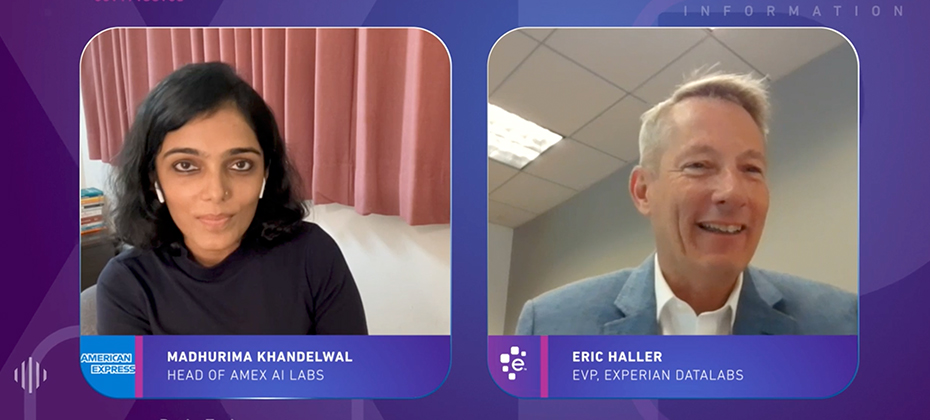Tag: artificial intelligence

From science fiction-worthy image generators to automated underwriting, artificial intelligence (AI), big data sets and advances in computing power are transforming how we play and work. While the focus in the lending space has often been on improving the AI models that analyze data, the data that feeds into the models is just as important. Enter: data-centric AI. What is a data-centric AI? Dr. Andrew Ng, a leader in the AI field, advocates for data-centric AI and is often credited with coining the term. According to Dr. Ng, data-centric AI is, ‘the discipline of systematically engineering the data used to build an AI system.’1 To break down the definition, think of AI systems as a combination of code and data. The code is the model or algorithm that analyzes data to produce a result. The data is the information you use to train the model or later feed into the model to request a result. Traditional approaches to AI focus on the code — the models. Multiple organizations download and use the same data sets to create and improve models. But today, continued focus on model development may offer a limited return in certain industries and use cases. A data-centric AI approach focuses on developing tools and practices that improve the data. You may still need to pay attention to model development but no longer treat the data as constant. Instead, you try to improve a model's performance by increasing data quality. This can be achieved in different ways, such as using more consistent labeling, removing noisy data and collecting additional data.2 Data-centric AI isn't just about improving data quality when you build a model — it's also part of the ongoing iterative process. The data-focused approach should continue during post-deployment model monitoring and maintenance. Data-centric AI in lending Organizations in multiple industries are exploring how a data-centric approach can help them improve model performance, fairness and business outcomes. For example, lenders that take a data-centric approach to underwriting may be able to expand their lending universe, drive growth and fulfill financial inclusion goals without taking on additional risk. Conventional credit scoring models have been trained on consumer credit bureau data for decades. New versions of these models might offer increased performance because they incorporate changes in the economic landscape, consumer behavior and advances in analytics. And some new models are built with a more data-centric approach that considers additional data points from the existing data sets — such as trended data — to score consumers more accurately. However, they still solely rely on credit bureau data. Explainability and transparency are essential components of responsible AI and machine learning (a type of AI) in underwriting. Organizations need to be able to explain how their models come to decisions and ensure they are behaving as expected. Model developers and lenders that use AI to build credit risk models can incorporate new high-quality data to supplement existing data sets. Alternative credit data can include information from alternative financial services, public records, consumer-permissioned data, and buy now, pay later (BNPL) data that lenders can use in compliance with the Fair Credit Reporting Act (FCRA).* The resulting AI-driven models may more accurately predict credit risk — decreasing lenders' losses. The models can also use alternative credit data to score consumers that conventional models can't score. Infographic: From initial strategy to results — with stops at verification, decisioning and approval — see how customers travel across an Automated Loan Underwriting Journey. Business benefit of using data-centric AI models Financial services organizations can benefit from using a data-centric AI approach to create models across the customer lifecycle. That may be why about 70 percent of businesses frequently discuss using advanced analytics and AI within underwriting and collections.3 Many have gone a step further and implemented AI. Underwriting is one of the main applications for machine learning models today, and lenders are using machine learning to:4 More accurately assess credit risk models. Decrease model development, deployment and recalibration timelines. Incorporate more alternative credit data into credit decisioning. AI analytics solutions may also increase customer lifetime value by helping lenders manage credit lines, increase retention, cross-sell products and improve collection efforts. Additionally, data-centric AI can assist with fraud detection and prevention. Case study: Learn how Atlas Credit, a small-dollar lender, used a machine learning model and loan automation to nearly doubled its loan approval rates while decreasing its credit risk losses. How Experian helps clients leverage data-centric AI for better business outcomes During a presentation in 2021, Dr. Ng used the 80-20 rule and cooking as an analogy to explain why the shift to data-centric AI makes sense.5 You might be able to make an okay meal with old or low-quality ingredients. However, if you source and prepare high-quality ingredients, you're already 80% of the way toward making a great meal. Your data is the primary ingredient for your model — do you want to use old and low-quality data? Experian has provided organizations with high-quality consumer and business credit solutions for decades, and our industry-leading data sources, models and analytics allow you to build models and make confident decisions. If you need a sous-chef, Experian offers services and has data professionals who can help you create AI-powered predictive analytics models using bureau data, alternative data and your in-house data. Learn more about our AI analytics solutions and how you can get started today. 1DataCentricAI. (2023). Data-Centric AI.2Exchange.scale (2021). The Data-Centric AI Approach With Andrew Ng.3Experian (2021). Global Insights Report September/October 2021.4FinRegLab (2021). The Use of Machine Learning for Credit Underwriting: Market & Data Science Context. 5YouTube (2021). A Chat with Andrew on MLOps: From Model-Centric to Data-Centric AI *Disclaimer: When we refer to “Alternative Credit Data," this refers to the use of alternative data and its appropriate use in consumer credit lending decisions, as regulated by the Fair Credit Reporting Act. Hence, the term “Expanded FCRA Data" may also apply in this instance and both can be used interchangeably.

The Federal Reserve (Fed) took a big step towards revolutionizing the U.S. payment landscape with the official launch of FedNow, a new instant payment service, on July 20, 2023. While the new payment network offers advantages, there are concerns that fraudsters may be quick to exploit the new real-time technology with fraud schemes like automated push payment (APP) fraud. How is FedNow different from existing payment networks? To keep pace with regions across the globe and accelerate innovation, the U.S. created a alternative to the existing payment network known as The Clearing House (TCH) Real-Time Payment Network (RTP). Fraudsters can use the fact that real-time payments immediately settle to launder the stolen money through multiple channels quickly. The potential for this kind of fraud has led financial regulators to consider measures to better protect against it. While both FedNow and RTP charge a comparable fee of 4.5 cents per originated transaction, the key distinction lies in their governance. RTP is operated by a consortium of large banks, whereas FedNow falls under the jurisdiction of the Federal Reserve Bank. This distinction could give FedNow an edge in the market. One of the advantages of FedNow is its integration with the extensive Federal Reserve network, allowing smaller local banks across the country to access the service. RTP estimates accessibility to institutions holding approximately 90% of U.S. demand deposit accounts (DDAs), but currently only reaches 62% of DDAs due to limited participation from eligible institutions. What are real-time payments? Real-time payments refer to transactions between bank accounts that are initiated, cleared, and settled within seconds, regardless of the time or day. This immediacy enhances transparency and instills confidence in payments, which benefits consumers, banks and businesses.Image sourced from JaredFranklin.com Real-time payments have gained traction globally, with adoptions from over 70 countries on six continents. In 2022 alone, these transactions amounted to a staggering $195 billion, representing a remarkable year-over-year growth of 63%. India leads the pack with its Unified Payments Interface platform, processing a massive $89.5 billion in transaction volume. Other significant markets include Brazil, China, Thailand, and South Korea. The fact that real-time payments cannot be reversed promotes trust and ensures that contracts are upheld. This also encourages the development of new methods to make processes more efficient, like the ability to pay upon receiving the goods or services. These advancements are particularly crucial for small businesses, which disproportionately bear the burden of delayed payments, amounting to a staggering $3 trillion globally at any given time. The launch of FedNow marks a significant milestone in the U.S. financial landscape, propelling the country towards greater efficiency, transparency, and innovation in payments. However, it also brings a fair share of challenges, including the potential for increased fraud. Are real-time payments a catalyst for fraud? As the financial landscape evolves with the introduction of real-time payment systems, fraudsters are quick to exploit new technologies. One particular form of fraud that has gained prominence is authorized push payment (APP) fraud. APP fraud is a type of scam where fraudsters trick individuals or businesses into authorizing the transfer of funds from their bank accounts to accounts controlled by the fraudsters. The fraudster poses as a legitimate entity and deceives the victim into believing that there is an urgent need to transfer money. They gain the victim's trust and provide instructions for the transfer, typically through online or telephone banking channels. The victim willingly performs the payment, thinking it is legitimate, but realizes they have been scammed when communication halts. APP fraud is damaging as victims authorize the payments themselves, making it difficult for banks to recover the funds. To protect against APP fraud, it's important to be cautious, verify the legitimacy of requests independently, and report any suspicious activity promptly. Fraud detection and prevention with real-time payments Advances in fraud detection software, including machine learning and behavioral analytics, make unusual urgent requests and fake invoices easier to spot — in real time — but some governments are considering legislation to ensure more support for victims. For example, in the U.K., frameworks like Confirmation of Payee have rolled out instant account detail checks against the account holder’s name to help prevent cases of authorized push payment fraud. The U.K.’s real-time payments scheme Pay.UK also introduced the Mule Insights Tactical Solution (MITS), which tracks the flow of fraudulent transactions used in money laundering through bank and credit union accounts. It identifies these accounts and stops the proceeds of crimes from moving deeper into the system – and can help victims recover their funds. While fraud levels related to traditional payments have slowly come down, real-time payment-related fraud has recently skyrocketed. India, one of the primary innovators in the space, recorded a 23% rise in fraud related to its real-time payments system in 2022. The same ACI report stated that the U.S., making up only 1.2% of all real-time payment transactions in 2022, had, for now, avoided the effects. However, “there is no reason to assume that without action, the U.S. will not follow the path to crisis levels of APP scams as seen in other markets.” FedNow currently has no specific plans to bake fraud detection into their newly launched technology, meaning the response is left to financial institutions. Fight instant fraud with instant answers Artificial Intelligence (AI) holds tremendous potential in combating the ever-present threat of fraud. With AI technologies, financial institutions can process vast amounts of data points faster and enhance their fraud detection capabilities. This enables them to identify and flag suspicious transactions that deviate from the norm, mitigating identity risk and safeguarding customer accounts. The ability of AI-powered systems to ingest and analyze real-time information empowers institutions to stay one step ahead in the battle against account takeover fraud. This type of fraud, which poses a significant challenge to real-time payment systems, can be better addressed through AI-enabled tools. With ongoing monitoring of account behavior, such as the services provided by FraudNet, financial institutions gain a powerful weapon against APP fraud. In addition to behavioral analysis, location data has emerged as an asset in the fight against fraud. Incorporating location-based information into fraud detection algorithms has proven effective in pinpointing suspicious activities and reducing fraudulent incidents. As the financial industry continues to grapple with the constant evolution of fraud techniques, harnessing the potential of AI, coupled with comprehensive data analysis and innovative technologies, becomes crucial for securing the integrity of financial transactions. Taking your next step in the fight against fraud Ultimately, the effectiveness of fraud prevention measures depends on the implementation and continuous improvement of security protocols by financial institutions, regulators, and technology providers. By staying vigilant and employing appropriate safeguards, fraud risks in real-time payment systems, such as FedNow, can be minimized. To learn more about how Experian can help you leverage fraud prevention solutions, visit us online or request a call. *This article leverages/includes content created by an AI language model and is intended to provide general information.

An intuitive digital customer experience in banking is more important than ever. Americans swipe, tap or insert their debit and credit cards at supermarkets, gas stations, restaurants, hotels and ATMs, conducting more than 74 million daily transactions.¹ Despite the volume of transactions, just 23% of banking customers give their bank high marks for its range of products, services and financial advice.² A hyper-digital, ever-changing banking industry means that there are more choices for financial service providers than ever before — and customers are taking full advantage of the options. On average, consumers have more than six different financial products and 82% of consumers between the ages of 18 and 24 acquired financial services products from new providers in the past 12 months.³ Digital transformation for banks is more crucial than ever, with some studies showing that 78% of bank customers prefer to access their accounts via a website or mobile app (with less than half of those surveyed ranking branch access as an important feature when shopping for a new checking account).4 Banks must embrace innovative strategies to elevate the banking customer experience in a competitive market. Here are some ways to boost customer retention and drive profitable growth. Rethink processes Complex processes and excessive paperwork needed to open accounts, approve credit cards and process loan applications can frustrate customers. In fact, more than 50% of consumers abandon the digital account opening process if it takes more than three to five minutes.5 Digital transformation initiatives can resolve these issues to improve the customer experience. Banks that leverage solutions, like artificial intelligence and automated data-driven decisioning solutions, to facilitate faster, more streamlined services can reduce friction, expedite processes and decrease wait times, resulting in improved customer satisfaction and retention. Reduce fragmentation Financial services are more fragmented than ever. Retail banking customers often use different providers for their checking and savings accounts, credit cards, investments, mortgages and other banking products. The options to access those accounts are also diverse, with customers choosing from brick-and-mortar branches, websites and mobile devices. Increased fragmentation means that the need to create an omnichannel experience should be top of mind for lenders. Additionally, the current retail banking landscape often fails to reward consumers for loyalty. Fewer than 15% of banks provide comprehensive rewards to those who use a single bank for multiple products or services, even though reducing fragmentation and taking a holistic approach to meeting customer needs can provide a competitive advantage.6 Personalize the digital experience While digital banking has reduced face-to-face interaction between banks and customers,7 consumers still expect a personalized banking experience. Experian has shown that using data analytics can lead to an improved understanding of customer needs and preferences, while customer segmentation enables the creation of targeted marketing campaigns, customized product offerings and tailored financial advice. These efforts towards a more personalized banking experience help increase customer satisfaction and loyalty. Provide more touchpoints An increasing number of branch closures and greater demand for digital banking services mean that just 3% of banking transactions are conducted in person.8 Customers are more willing to use digital channels for services like opening accounts and applying for loans. Banks can promote credit offers and product recommendations via email, social media and mobile banking applications while providing real-time digital customer experiences and prioritizing consistency across channels. Embracing a multichannel approach to marketing can help banks achieve better results, making it easier to cross-sell customers, amplify offers and meet consumer expectations for a personalized digital experience. Go beyond banking The customer experience in banking is about more than deposits, withdrawals and interest payments. Customers want resources and information to improve their financial well-being — and providing it can build trust, improve customer retention and boost revenue. Using digital channels to provide education might be more effective than encouraging appointments with customer service representatives. These tactics can help you: Leverage artificial intelligence to provide educational resources and personalized financial advice. Monitor user transactions for unusual activities and push information about online security or fraud protection. Employ chatbots to provide investment information and credit score monitoring and respond to questions about products ranging from mortgages to credit cards. Enhance your customer retention strategies by focusing on credit education and helping customers at every stage of their financial lives. Deliver a personalized customer experience in banking Globally, banks have invested $124 billion in artificial intelligence, machine learning and other technologies to make retail banking services more efficient and effective.9 Personalization is still imperative, and putting the customer first must remain the highest priority. Achieving those results requires a solid strategy for an improved banking customer experience. Experian leverages customer-level analytics and provides comprehensive solutions to expand digital transformation efforts, drive acquisition and improve customer retention. Learn more about our banking solutions. Learn more ¹Federal Reserve (2023). Commercial Automated Clearinghouse Transactions Processed by the Federal Reserve2,6-9Accenture (2023). Global Banking Customer Study3-4Forbes Advisor (2023). U.S. Consumer Banking Statistics5The Financial Brand (2023). How Credit Card Issuers Are Tackling Application Abandonment

"Grandma, it’s me, Mike.” Imagine hearing the voice of a loved one (or what sounds like it) informing you they were arrested and in need of bail money. Panicked, a desperate family member may follow instructions to withdraw a large sum of money to provide to a courier. Suspicious, they even make a video call to which they see a blurry image on the other end, but the same voice. When the fight or flight feeling settles, reality hits. Sadly, this is not the scenario of an upcoming Netflix movie. This is fraud – an example of a new grandparent scam/family emergency scam happening at scale across the U.S. While generative AI is driving efficiencies, personalization and improvements in multiple areas, it’s also a technology being adopted by fraudsters. Generative AI can be used to create highly personalized and convincing messages that are tailored to a specific victim. By analyzing publicly available social media profiles and other personal information, scammers can use generative AI to create fake accounts, emails, or phone calls that mimic the voice and mannerisms of a grandchild or family member in distress. The use of this technology can make it particularly difficult to distinguish between real and fake communication, leading to increased vulnerability and susceptibility to fraud. Furthermore, generative AI can also be used to create deepfake videos or audio recordings that show the supposed family member in distress or reinforce the scammer's story. These deepfakes can be incredibly realistic, making it even harder for victims to identify fraudulent activity. What is Generative AI? Generative artificial intelligence (GenAI) describes algorithms that can be used to create new content, including audio, code, images, text, simulations, and videos. Generative AI has the potential to revolutionize many industries by creating new and innovative content, but it also presents a significant risk for financial institutions. Cyber attackers can use generative AI to produce sophisticated malware, phishing schemes, and other fraudulent activities that can cause data breaches, financial losses, and reputational damage. This poses a challenge for financial organizations, as human error remains one of the weakest links in cybersecurity. Fraudsters capitalizing on emotions such as fear, stress, desperation, or inattention can make it difficult to protect against malicious content generated by generative AI, which could be used as a tactic to defraud financial institutions. Four types of Generative AI used for Fraud: Fraud automation at scale Fraudulent activities often involve multiple steps which can be complex and time-consuming. However, GenAI may enable fraudsters to automate each of these steps, thereby establishing a comprehensive framework for fraudulent attacks. The modus operandi of GenAI involves the generation of scripts or code that facilitates the creation of programs capable of autonomously pilfering personal data and breaching accounts. Previously, the development of such codes and programs necessitated the expertise of seasoned programmers, with each stage of the process requiring separate and fragmented development. Nevertheless, with the advent of GenAI, any fraudster can now access an all-encompassing program without the need for specialized knowledge, amplifying the inherent danger it poses. It can be used to accelerate fraudsters techniques such as credential stuffing, card testing and brute force attacks. Text content generation In the past, one could often rely on spotting typos or errors as a means of detecting such fraudulent schemes. However, the emergence of GenAI has introduced a new challenge, as it generates impeccably written scripts that possess an uncanny authenticity, rendering the identification of deceit activities considerably more difficult. But now, GenAI can produce realistic text that sounds as if it were from a familiar person, organization, or business by simply feeding GenAI prompts or content to replicate. Furthermore, the utilization of innovative Language Learning Model (LLM) tools enables scammers to engage in text-based conversations with multiple victims, skillfully manipulating them into carrying out actions that ultimately serve the perpetrators' interests. Image and video manipulation In a matter of seconds, fraudsters, regardless of their level of expertise, are now capable of producing highly authentic videos or images powered by GenAI. This innovative technology leverages deep learning techniques, using vast amounts of collected datasets to train artificial intelligence models. Once these models are trained, they possess the ability to generate visuals that closely resemble the desired target. By seamlessly blending or superimposing these generated images onto specific frames, the original content can be replaced with manipulated visuals. Furthermore, the utilization of AI text-to-image generators, powered by artificial neural networks, allows fraudsters to input prompts in the form of words. These prompts are then processed by the system, resulting in the generation of corresponding images, further enhancing the deceptive capabilities at their disposal. Human voice generation The emergence of AI-generated voices that mimic real people has created new vulnerabilities in voice verification systems. Firms that rely heavily on these systems, such as investment firms, must take extra precautions to ensure the security of their clients' assets. Criminals can also use AI chatbots to build relationships with victims and exploit their emotions to convince them to invest money or share personal information. Pig butchering scams and romance scams are examples of these types of frauds where AI chatbots can be highly effective, as they are friendly, convincing, and can easily follow a script. In particular, synthetic identity fraud has become an increasingly common tactic among cybercriminals. By creating fake personas with plausible social profiles, hackers can avoid detection while conducting financial crimes. It is essential for organizations to remain vigilant and verify the identities of any new contacts or suppliers before engaging with them. Failure to do so could result in significant monetary loss and reputational damage. Leverage AI to fight bad actors In today's digital landscape, businesses face increased fraud risks from advanced chatbots and generative technology. To combat this, businesses must use the same weapons than criminals, and train AI-based tools to detect and prevent fraudulent activities. Fraud prediction: Generative AI can analyze historical data to predict future fraudulent activities. By analyzing patterns in data and identifying potential risk factors, generative AI can help fraud examiners anticipate and prevent fraudulent behavior. Machine learning algorithms can analyze patterns in data to identify suspicious behavior and flag it for further investigation. Fraud Investigation: In addition to preventing fraud, generative AI can assist fraud examiners in investigating suspicious activities by generating scenarios and identifying potential suspects. By analyzing email communications and social media activity, generative AI can uncover hidden connections between suspects and identify potential fraudsters. To confirm the authenticity of users, financial institutions should adopt sophisticated identity verification methods that include liveness detection algorithms and document-centric identity proofing, and predictive analytics models. These measures can help prevent bots from infiltrating their systems and spreading disinformation, while also protecting against scams and cyberattacks. In conclusion, financial institutions must stay vigilant and deploy new tools and technologies to protect against the evolving threat landscape. By adopting advanced identity verification solutions, organizations can safeguard themselves and their customers from potential risks. To learn more about how Experian can help you leverage fraud prevention solutions, visit us online or request a call

Using data to understand risk and make lending decisions has long been a forte of leading financial institutions. Now, with artificial intelligence (AI) taking the world by storm, lenders are finding innovative ways to improve their analytical capabilities. How AI analytics differs from traditional analytics Data analytics is analyzing data to find patterns, relationships and other insights. There are four main types of data analytics: descriptive, diagnostic, predictive and prescriptive. In short, understanding the past and why something happened, predicting future outcomes and offering suggestions based on likely outcomes. Traditionally, data analysts and scientists build models and help create decisioning strategies to align with business needs. They may form a hypothesis, find and organize relevant data and then run analytics models to test their hypothesis. However, time and resource constraints can limit the traditional analytics approach. As a result, there might be a focus on answering a few specific questions: Will this customer pay their bills on time? How did [X] perform last quarter? What are the chances of [Y] happening next year? AI analytics isn't completely different — think of it as a complementary improvement rather than a replacement. It relies on advances in computing power, analytics techniques and different types of training to create models more efficient than traditional analytics. By leveraging AI, companies can automate much of the data gathering, cleaning and analysis, saving them time and money. The AI models can also answer more complex questions and work at a scale that traditional analytics can't keep up with. Advances in AI are additionally offering new ways to use and interact with data. Organizations are already experimenting with using natural language processing and generative AI models. These can help even the most non-technical employees and customers to interact with vast amounts of data using intuitive and conversational interfaces. Benefits of AI analytics The primary benefits of AI-driven analytics solutions are speed, scale and the ability to identify more complex relationships in data. Speed: Where traditional analytics might involve downloading and analyzing spreadsheets to answer a single question, AI analytics automates these processes – and many others.Scale: AI analytics can ingest large amounts of data from multiple data sources to find analytical insights that traditional approaches may miss. When combined with automation and faster processing times, organizations can scale AI analytics more efficiently than traditional analytics.Complexity: AI analytics can answer ambiguous questions. For example, a marketing team may use traditional analytics to segment customers by known characteristics, such as age or location. But they can use AI analytics to find segments based on undefined shared traits or interests, and the results could include segments that they wouldn't have thought to create on their own. The insights from data analytics might be incorporated into a business intelligence platform. Traditionally, data analysts would upload reports or update a dashboard that business leaders could use to see the results and make educated decisions. Modern business intelligence and analytics solutions allow non-technical business leaders to analyze data on their own. With AI analytics running in the background, business leaders can quickly and easily create their own reports and test hypotheses. The AI-powered tools may even be able to learn from users' interactions to make the results more relevant and helpful over time. WATCH: See how organizations are using business intelligence to unlock better lending decisions with expert insights and a live demo. Using AI analytics to improve underwriting From global retailers managing supply chains to doctors making life-changing diagnoses, many industries are turning to AI analytics to make better data-driven decisions. Within financial services, there are significant opportunities throughout customer lifecycles. For example, some lenders use machine learning (ML), a subset of AI, to help create credit risk models that estimate the likelihood that a borrower will miss a payment in the future. Credit risk models aren't new — lenders have used models and credit scores for decades. However, ML-driven models have been able to outperform traditional credit risk models by up to 15 percent.1 In part, this is because the machine learning models might use traditional credit data and alternative credit data* (or expanded FCRA-regulated data), including information from alternative financial services and buy now pay later loans. They can also analyze the vast amounts of data to uncover predictive attributes that logistic regression (a more traditional approach) models might miss. The resulting ML models can score more consumers than traditional models and do so more accurately. Lenders that use these AI-driven models may be able to expand their lending universe and increase automation in their underwriting process without taking on additional risk. However, lenders may need to use a supervised learning approach to create explainable models for credit underwriting to comply with regulations and ensure fair lending practices. Read: The Explainability: ML and AI in credit decisioning report explores why ML models will become the norm, why explainability is important and how to use machine learning. Experian helps clients use AI analytics Although AI analytics can lead to more productive and efficient analytics operations over time, the required upfront cost or expertise may be prohibitive for some organizations. But there are simple solutions. Built with advanced analytics, our Lift Premium™ scoring model uses traditional and alternative credit data to score more consumers than conventional scoring models. It can help organizations increase approvals among thin-file and credit-invisible consumers, and more accurately score thick-file consumers.2 Experian can also help you create, test, deploy and monitor AI models and decisioning strategies in a collaborative environment. The models can be trained on Experian's vast data sources and your internal data to create a custom solution that improves your underwriting accuracy and capabilities. Learn more about machine learning and AI analytics. * When we refer to “Alternative Credit Data," this refers to the use of alternative data and its appropriate use in consumer credit lending decisions as regulated by the Fair Credit Reporting Act (FCRA). Hence, the term “Expanded FCRA Data" may also apply in this instance and both can be used interchangeably. 1. Experian (2020). Machine Learning Decisions in Milliseconds 2. Experian (2022). Lift PremiumTM product sheet

Machine learning (ML) is a powerful tool that can consume vast amounts of data to uncover patterns, learn from past behaviors, and predict future outcomes. By leveraging ML-powered credit risk models, lenders can better determine the likelihood that a consumer will default on a loan or credit obligation, allowing them to score applicants more accurately. When applied to credit decisioning, lenders can achieve a 25 percent reduction in exposure to risky customers and a 35 percent decrease in non-performing loans.1 While ML-driven models enable lenders to target the right audience and control credit losses, many organizations face challenges in developing and deploying these models. Some still rely on traditional lending models with limitations preventing them from making fast and accurate decisions, including slow reaction times, fewer data sources, and less predictive performance. With a trusted and experienced partner, financial institutions can create and deploy highly predictive ML models that optimize their credit decisioning. Case study: Increase customer acquisition with improved predictive performance Looking to meet growth goals without increasing risk, a consumer goods retailer sought out a modern and flexible solution that could help expand its finance product options. This meant replacing existing ML models with a custom model that offers greater transparency and predictive power. The retailer partnered with Experian to develop a transparent and explainable ML model. Based on the model’s improved predictive performance, transparency, and ability to derive adverse action reasons for declines, the retailer increased sales and application approval rates while reducing credit risk. Read the case study Learn about our custom modeling capabilities 1 Experian (2020). The Art of Decisioning in Uncertain Times

From chatbots to image generators, artificial intelligence (AI) has captured consumers' attention and spurred joy — and sometimes a little fear. It's not too different in the business world. There are amazing opportunities and lenders are increasingly turning to AI-driven lending decision engines and processes. But there are also open questions about how AI can work within existing regulatory requirements, how new regulations will impact its use and how to implement advanced analytics in a way that increases equitable inclusion rather than further embedding disparities. How are lenders using AI today? Many financial institutions have implemented — or at least tested — AI-driven tools throughout the customer lifecycle to: Target the right consumers: With tools like Ascend Intelligence ServicesTM Target (AIS Target), lenders can better identify consumers who match their credit criteria and send right-sized offers, which enables them to maximize their acceptance rates. Detect and prevent fraud: Fraud detection tools have used AI and machine learning techniques to detect and prevent fraud for years. These systems may be even more important as new fraud risks emerge, from tried-and-true methods to generative AI (GenAI) fraud. Assess creditworthiness: ML-based models can incorporate a range of internal and external data points to more precisely evaluate creditworthiness. When combined with traditional and alternative credit data*, some lenders can even see a Gini uplift of 60 to 70 percent compared to a traditional credit risk model. Manage portfolios: Lenders can also use a more complete picture of their current customers to make better decisions. For example, AI-driven models can help lenders set initial credit limits and suggest when a change could help them increase wallet share or reduce risk. Lenders can also use AI to help determine which up- and cross-selling offers to present and when (and how) to reach out. Improve collections: Models can be built to ease debt collection processes, such as choosing where to assign accounts, which accounts to prioritize and how to contact the consumer. Additionally, businesses can implement AI-powered tools to increase their organizations' productivity and agility. GenAI solutions like Experian Assistant accelerate the modeling lifecycle by providing immediate responses to questions, enhancing model transparency and parsing through multiple model iterations quickly, resulting in streamlined workflows, improved data visibility and reduced expenses. WATCH: Explore best practices for building, fine-tuning and deploying robust machine learning models for credit risk. The benefits of AI in lending Although lenders can use machine learning models in many ways, the primary drivers for adoption in underwriting include: Improving credit risk assessment Faster development and deployment cycles for new or recalibrated models Unlocking the possibilities within large datasets Keeping up with competing lenders Some of the use cases for machine learning solutions have a direct impact on the bottom line — improving credit risk assessment can decrease charge-offs. Others are less direct but still meaningful. For instance, machine learning models might increase efficiency and allow further automation. This takes the pressure off your underwriting team, even when application volume is extremely high, and results in faster decisions for applicants, which can improve your customer experience. Incorporating large data sets into their decisions also allows lenders to expand their lending universe without taking on additional risk. For example, they may now be able to offer risk-appropriate credit lines to consumers that traditional scoring models can't score. And machine learning solutions can increase customer lifetime value when they're incorporated throughout the customer lifecycle by stopping fraud, improving retention, increasing up- or cross-selling and streamlining collections. Hurdles to adoption of machine learning in lending There are clear benefits and interest in machine learning and analytics, but adoption can be difficult, especially within credit underwriting. A recent Forrester Consulting study commissioned by Experian found that the top pain points for technology decision makers in financial services were reported to be automation and availability of data. Explainability comes down to transparency and trust. Financial institutions have to trust that machine learning models will continue to outperform traditional models to make them a worthwhile investment. The models also have to be transparent and explainable for financial institutions to meet regulatory fair lending requirements. A lack of resources and expertise could hinder model development and deployment. It can take a long time to build and deploy a custom model, and there's a lot of overhead to cover during the process. Large lenders might have in-house credit modeling teams that can take on the workload, but they also face barriers when integrating new models into legacy systems. Small- and mid-sized institutions may be more nimble, but they rarely have the in-house expertise to build or deploy models on their own. The models also have to be trained on appropriate data sets. Similar to model building and deployment, organizations might not have the human or financial resources to clean and organize internal data. And although vendors offer access to a lot of external data, sometimes sorting through and using the data requires a large commitment. How Experian is shaping the future of AI in lending Lenders are finding new ways to use AI throughout the customer lifecycle and with varying types of financial products. However, while the cost to create custom machine learning models is dropping, the complexities and unknowns are still too great for some lenders to manage. But that's changing. Experian built the Ascend Intelligence Services™ to help smaller and mid-market lenders access the most advanced analytics tools. The managed service platform can significantly reduce the cost and deployment time for lenders who want to incorporate AI-driven strategies and machine learning models into their lending process. The end-to-end managed analytics service gives lenders access to Experian's vast data sets and can incorporate internal data to build and seamlessly deploy custom machine learning models. The platform can also continually monitor and retrain models to increase lift, and there's no “black box" to obscure how the model works. Everything is fully explainable, and the platform bakes regulatory constraints into the data curation and model development to ensure lenders stay compliant. Learn more * When we refer to “Alternative Credit Data," this refers to the use of alternative data and its appropriate use in consumer credit lending decisions as regulated by the Fair Credit Reporting Act (FCRA). Hence, the term “Expanded FCRA Data" may also apply in this instance and both can be used interchangeably.

It's one thing to make a corporate commitment to financial inclusion, but quite another to set specific goals and measure outcomes. What goals should lenders set to make financial inclusion a reality? How can success be quantified? What actionable steps must be taken to put policy into practice? The road to financial inclusion may feel long, but this step-by-step checklist can help you measure diversity and achieve goals to become more inclusive as an organization. Step 1: Set quantifiable goals with realistic outcomes Start by defining what you plan to achieve with a financial inclusion strategy. When setting goals, Alpa Lally, Experian's Vice President of Data Business at Consumer Information Services, recommends organizations "assess the strategic opportunity at the enterprise level." "It is important that KPIs are aligned across each business unit and functional groups in order to understand the investment opportunity and what the business must achieve together," said Lally. "The key focus here is 'together', the path to financial inclusion is a journey for all groups and everyone must participate, be committed and be aligned to be successful." Figuring out your short- and long-term goals should be the first step to kickstarting a financial inclusion strategy. But equally important is driving towards outcomes. For instance, if the goal is to increase the number of loans made to previously overlooked or excluded consumers, you may want to start by examining your declination population to better understand who is being left out. Or if financial inclusion is tied to a wider strategy or vision on corporate social responsibility, your goals may include an education component, community outreach, and a re-examination of your hiring practices. No matter what KPIs you're using, here are relevant questions to ask in four key areas – which will help draw out your organizational goals and priorities: Organizational awareness: What action is your organization taking to enhance Diversity, Equity and Inclusion and embrace Corporate Social Responsibility (CSR) around financial inclusion? If you already have financial inclusion programs in place, what are the primary goals? Barriers: What barriers prevent the organization from pursuing equity, diversity and inclusion programs? Education: How do you create awareness and education around financial inclusion? Which community or third-party organizations can help you reach consumers who aren't aware of ways to access financial services? Markers of success: What benchmarks will your organization use to measure and analyze success? Step 2: Do a financial inclusion audit Before developing and implementing a robust financial inclusion program, Lally recommends conducting a financial inclusion audit – which is a "detailed assessment of where you are today, relative to the goals and results you've outlined". In a nutshell, it allows you to assess your current systems and results within your financial institution. According to Lally, a financial inclusion audit should address the following key areas: Roadmap: What are your strategic priorities and how will financial inclusion fit within them? Tracking: Track the actual volume and distribution of different underserved populations (e.g., young adults, low-income communities, immigrants, etc.) within your book of business. Look at the applications and the approval rates by segment. In addition, assess the interest rates these consumers are offered by credit score bands for each group: “Benchmarking is critical. Understanding how they compare to national averages? How do they compare to the rest of your portfolio?" said Lally. Hiring practices: Is diversity, equity and inclusion (DEI) central to your talent management strategy? Is there a link between a lack of DEI in hiring practices and the level of financial inclusion within an organization? Affordability and access: Determine if the products and services you offer are easily accessible, can be understood by a reasonable consumer and are affordable to a broad base. Internal practices: What policies exist that influence the culture and behavior of employees around financial inclusion? Partnerships: Identify outside organizations that can help you develop financial literacy programs to promote financial inclusion. Advertising: Does your advertising promote equal and diverse representation across a wide range of consumer groups? Tools to measure: Are you financially inclusive as a company? How can you improve? The Bayesian Improved Surname Geocoding (BISG) method used by the Consumer Financial Protection Bureau (CFPB) predicts the probability of an individual's race and ethnicity based on demographic information associated with the consumer's surname. Lenders can use this type of information to conduct internal audits or set benchmarks to help ensure accountability in their diversity goals. Step 3: Tap into technology New technology is emerging that gives lenders powerful tools to evaluate a wider pool of prospective borrowers while also mitigating risk. For instance, scoring models that incorporate expanded FCRA-regulated data provide greater insight into 'credit invisible' or 'unscorable' consumers because they look at a wider set of data assets (or 'alternative data'), which allows lenders to assess a larger pool of applicants. It also improves the accuracy of those scores and better assesses the creditworthiness of consumers. Consider these resources, among others: Lift Premium™: Experian estimates that lenders using Lift Premium™ can score 96 percent of U.S. adults, a vast improvement over the 81 percent that are scorable today with conventional scores relying on mainstream data. Such enhanced scores would enable six million consumers who are considered subprime today to qualify for “mainstream" (prime or near-prime) credit. Experian® RentBureau®: RentBureau collects rent payment data from landlords and management companies, which allows consumers to leverage positive rent payment history similarly to how consumers leverage consistent mortgage payments. Clarity Credit Data: Clarity Credit Data allows lenders to see how consumers use alternative financial products and examine payment behaviors that might exist outside of the traditional credit report. Clarity's expanded FCRA -regulated data provides a deeper view of the consumer, allowing lenders to identify those who may not have previously been classified as "at risk" and approve consumers that may have previously been denied using a traditional credit score. Income Verification: Consumers can grant access to their bank accounts so lenders can assess their ability to pay based on verified income and cash flow. In addition, artificial intelligence (AI) and greater automation can reduce operational costs for lenders, while increasing the affordability of financial products and services for customers. AI and machine learning (ML) can also improve risk profiling and credit decisioning by filling in some of the gaps where credit history is not available. These are just a few examples of a wide range of cutting-edge solutions and technologies that enable lenders to promote greater financial inclusion through their decisioning processes. As new solutions are introduced to the market, it is imperative that lenders look into these technologies to help grow their business. Step 4: Monitor and measure Measuring your progress on financial inclusion isn't a one-and-done proposition. After you've set your goals and created a roadmap, it's important to continue monitoring and measuring your progress. That means your performance to gauge the impact of financial inclusion at both the community and business levels. Lally recommends the following examples: Compare your lending pool to the latest population data from the United States census. Is your portfolio representative of the U.S. population or are there segments that should have greater access? How does it compare against other lenders competing in the same space? Keep in mind that it has been widely reported that certain populations were undercounted, so you may want to factor this reality into your assessments. Work to understand how traditionally underserved consumers are performing in terms of their payment behaviors, purchase patterns and delinquencies. Measure the impact of financial inclusion on your company's overall revenue growth, ROI and brand reputation. Conduct an analysis to better understand your company's brand reputation, how it's perceived across different groups and what your customers are saying. Last word Financial inclusion represents a big step towards closing the wealth gap and helping marginalized communities build generational wealth. Given the prevalence of socioeconomic and racial inequality in our country today, it's a complex issue that disproportionately impacts marginalized groups, such as consumers of color, low-income communities and immigrants. Adopting more financially inclusive practices can help improve access to credit for these groups. For financial institutions and lenders, the first step is to identify realistic, quantifiable goals. A successful financial inclusion initiative also hinges on completing a financial inclusion audit, tapping into the right technology and continually monitoring and measuring progress. "It is paramount that financial institutions hold themselves accountable and demonstrate their commitment to make these practices a part of their DNA." - Alpa Lally. Learn more

At Experian, we know that financial institutions, fintechs and lenders across the entire spectrum – small, medium and large, are further exploring and adopting AI-powered solutions to unlock growth and improve operational efficiencies. With increasing competition and a dynamic economy, AI-driven strategies across the entire customer lifecycle are no longer a nice to have, they are a must. Our dedication to delivering on this need for our clients is why we are thrilled to be recognized as a Fintech Breakthrough Award winner for the fifth consecutive year. Experian’s Ascend Intelligence ServicesTM (AIS) platform hosts a suite of analytics solutions and has been named “Best Consumer Lending Product” in the sixth annual FinTech Breakthrough Awards. This awards program is conducted by FinTech Breakthrough, an independent market intelligence organization that recognizes the top companies, technologies and products in the global fintech market today. This is the second consecutive year that AIS has been recognized with a FinTech Breakthrough Award, previously being selected for the “Consumer Lending Innovation Award” in 2021. “Winning another award from FinTech Breakthrough is a fantastic validation of the success and momentum of our Ascend Intelligence Services suite. Now more than ever, the world is in a state of constant change and companies are being reactive, with data scientists spending too much time on manual, repetitive data-wrangling tasks, at a time when they cannot afford to do so,” said Shri Santhanam, Experian’s executive vice president and general manager of Global Analytics and AI. “Companies need to be able to rapidly develop and deploy ML-powered models in an agile way at low cost. We are now able to offer this to more lenders no matter their size.” With AIS, Experian can empower financial services firms to make the best decisions across the customer life cycle with rapid model and strategy build, seamless deployment, optimization and continuous monitoring. The AIS suite is comprised of two key solution models: Ascend Intelligence Services Acquire is a managed services offering that enables financial institutions to increase approval rates and control bad debt by acquiring the right customers and providing the best offers. This is accomplished through a rapid AI/ML model build that will help better quantify the risk of an individual applicant. Next, a mathematically optimized decision strategy is designed to provide a more granular view of the applicant and help make the best decision possible based on the institution’s specific business goals and constraints. The combination of the AI/ML model and optimized decision strategy provides increased predictive power that mitigates risk and allows more automated decisions to be made. The model and strategy are seamlessly deployed to help deliver business value quickly. Ascend Intelligence Services™ Limit enables financial institutions to make the right credit limit decisions at account origination and during account management. Limit uses Experian’s data, predictive risk and balance models and our powerful optimization engine to design the right credit limit strategy that maximizes product usage, while keeping losses low. To learn more about how Ascend Intelligence Services can support your business, please explore our solutions page. Learn more For a list of all award winners selected for the 2022 FinTech Breakthrough Awards, click here.

Experian’s newest Global Insights Report found that consumers are online 25% more today than they were just a year ago, highlighting the importance of the digital customer experience. To acquire customers and retain their loyalty, businesses need to focus on improving the online experience, preventing fraud, and managing credit risk. This September, Experian surveyed 3,000 consumers and 900 businesses across all industries to explore business priorities and recent changes in consumer activities. Many businesses and consumers are reportedly feeling more economically stable now than they were a year ago. As consumers resume spending the digital customer experience becomes even more paramount – requiring businesses to invest in scalable software solutions that will accurately assess credit risk and meet ever-changing needs and priorities. Our research found that: 42% of consumers have increased concern for the safety of banking and shopping transactions Business adoption of advanced analytics has increased over last year, and adoption of artificial intelligence is up from 69% to 74% Consumers are more likely to share their personal data if it improves their experience, with 56% willing to share their contact information The top three consumer priorities continue to be security, privacy and convenience Download the report to get all the latest insights into consumer desires and business behaviors as we move further through the digital evolution. Download the report

It is no news that businesses are increasing their focus on advanced analytics and models. Whether looking to increase resources or focus on artificial intelligence (AI) and machine learning (ML), growth is the name of the game. But how do you maximize impact while minimizing risk? And how can you secure expertise and ROI when budgets are strapped? Does your organization have the knowledge and talent in-house to remain competitive? No matter where you are on the analytics maturity curve, (outlined in detail below), your organization can benefit from making sure your machine learning models solution consists of: Regulatory documentation: Documentation for model and strategy governance is critical, especially as there is more conversation surrounding fair lending and how it relates to machine learning models. How does your organization ensure your models are explainable, well documented and making fair decisions? These are all questions you must be asking of your partners and solutions. Integrated services: For some service providers, “integrated,” is merely a marketing ploy, but it is essential that your solution truly integrates attributes, scores, models and decisions into one another. Not only does this serve as a “checks and balances” system of sorts, but it also is a primary driver for the speed of decisioning, which is crucial in today’s digital-first world. Deep expertise: Models are a major component for your decisioning, but ensuring those models are built and backed by experts is the one-two punch your strategies depend on. Make sure your services are managed by data scientists with extensive experience to take the best approach to solving your business problems. Usability: Does your solution close the loop? To future proof your processes, your solution must analyze the performance of attributes, scores and strategies. On top of that, your solution should make sure the items being built are useable and can be modified when needed. A one-and-done model does not suit the unique needs of your organization, so ensure your solution provides actionable analysis for continual refinement. Does your machine learning model solution check these boxes? Do you want to transform your existing system into a state-of-the-art AI platform? Learn more about how you can take your business challenges head-on by rapidly developing, deploying and monitoring sophisticated models and strategies to more accurately predict risk and achieve better outcomes. Learn more Access infographic More information: What’s the analytics maturity curve? “Analytics” is the discovery, interpretation and communication of meaningful patterns in data; the connective tissue between data and effective decision-making within an organization. You can be along this journey for different decision points you’re making or product types, said Mark Soffietti, Director of Analytics Consulting at Experian, at our recent AI-driven analytics and strategy optimization webinar. Where you are on this curve often depends on your organization’s use of generic versus custom scores, the systems currently engaged to make those decisions and the sophistication of an organization’s models and/or strategies. Here’s a breakdown of each of the four stages: Descriptive Analytics – Descriptive analytics is the first step of the analytics maturity curve. These analytics answer the question “What is happening?” and typically revolve around some form of reporting. An example would be the information that your organization received 100 applications. Diagnostic Analytics – These analytics move from what happened to, “Why did it happen?” By digging into the 100 applications received, diagnostic analytics answer questions like “Who were we targeting?” and “How did those people come into our online portal/branch?” This information helps organizations be more strategic in their practices. Predictive Analytics – Models come into play at this stage as organizations try to predict what will happen. Based on the data set and an understanding of what the organization is doing, effort is put towards automating information to better solve business problems. Prescriptive Analytics – Optimization is key for prescriptive analytics. At this point in the maturity curve, there are multiple models and/or information that may be competing against one another. Prescriptive analytics will attempt to prescribe what an organization is doing and how it can drive more desired behaviors. For more information and to get personalized recommendations throughout your analytics journey, visit our website.

Chatbots, reduction of manual processes and explainability were all hot topics in a recent discussion between Madhurima Khandelwal, Vice President and Head of DataLabs at American Express®, and Eric Haller, Executive Vice President and head of Experian DataLabs. The importance of AI’s role in innovation in the financial services space was the focus of the recent video interview. In the interview, Khandelwal highlighted some of the latest in what American Express DataLabs is working on to continue to solve complex challenges by building tools driven by AI and Machine Learning: Natural language processing has come a long way in even the last few years. Khandelwal discussed how chat bots and conversational AI can automate the simple to complex to enhance customer experience. Document recognition and processing is another leading-edge innovation that is useful for extracting and analyzing information, which saves staff countless manual hours, Khandelwal said. Fairness and explainability are consistently brought to the forefront especially in financial services as regulators are looking at ways to prevent AI/ML from causing bias for the consumer. Khandelwal showcased how there is extreme rigor in each part of creating their models and how human oversight and training are primary drivers for how they stay on top of this. As for innovation advice, Khandelwal points out that it’s important to be aware that AI and innovation are not always interchangeable, and companies need to think through whether a problem needs to be solved through AI/ML models before charting ahead. Another major key to the equation is the data. In all use cases, the undercurrent of innovation in any form is dependent on the data being used. Learn more about this topic and what Harry Potter has to do with women in data science. Watch the Interview

It’s time for organizations to harness the power artificial intelligence (AI) can bring to digital identity management – quickly and accurately identifying consumers throughout the lifecycle. The rise in crime The acceleration to digital platforms created a perfect storm of new opportunities for fraudsters. Synthetic identity fraud, stimulus-related fraud, and other types of cybercrime have seen huge upticks within the past year and a half. In fact, the Federal Trade Commission revealed that consumers reported over 360,000 complaints, resulting in more than $580 million in COVID-19-related fraud losses as of October 2021. To protect both themselves and consumers, businesses — especially lenders — will have to find and incorporate new strategies to identify customers, deter fraudsters and mitigate cybercrime. The benefits of AI for digital identity In our latest e-book, we explore the impacts of AI on organizations’ digital identity strategies, including: How changing consumer expectations increased the need for speed The challenges associated with both AI and digital identities The path forward for digital identity and AI How to develop the right strategy Building a solution It’s clear that current digital identity and fraud prevention tools are not enough to stop cybercriminals. To stay ahead of fraudsters and keep consumers happy, businesses need to look to new technologies — ones that can intake and compute large data sets in near-real time for better and faster decisions throughout the customer lifecycle. By using AI, businesses will enjoy a fast and consistent decisioning system that automatically routes questionable identities to additional authentication steps, allowing employees to focus on the riskiest cases and maximizing efficiency. Read our latest e-book to dive into the ways artificial intelligence and digital identity interact, and the benefits a clear identity strategy can have for the entire user journey. Download the e-book

Shri Santhanam, Executive Vice President and General Manager of Global Analytics and Artificial Intelligence (AI) was recently featured on Lendit’s ‘Fintech One-on-One’ podcast. Shri and podcast creator, Peter Renton, discussed advanced analytics and AI’s role in lending and how Experian is helping lenders during what he calls the ‘digital lending revolution.’ Digital lending revolution “Over the last decade and a half, the notion of digital tools, decisioning, analytics and underwriting has come into play. The COVID-19 pandemic has dramatically accelerated that, and we’re seeing three big trends shake up the financial services industry,” said Shri. A shift in consumer expectations More than ever before, there is a deep focus on the customer experience. Five or six years ago, consumers and businesses were more accepting of waiting several days, sometimes even weeks, for loan approvals and decisions. However, the expectation has dramatically changed. In today’s digital world, consumers expect lending institutions to make quick approvals and real-time decisions. Fintechs being quick to act Fintech lenders have been disrupting the traditional financial services space in ways that positively impacts consumers. They’ve made it easier for borrowers to access credit – particularly those who have been traditional excluded or denied – and are quick to identify, develop and distribute market solutions. An increased adoption of machine learning, advanced analytics and AI Fintechs and financial institutions of all sizes are further exploring using AI-powered solutions to unlock growth and improve operational efficiencies. AI-driven strategies, which were once a ‘nice-to-have,’ have become a necessity. To help organizations reduce the resources and costs associated with building in-house models, Experian has launched Ascend Intelligence Services™, an analytics solution delivered on a modern tech AI platform. Ascend Intelligence Services helps streamline model builds and increases decision automation and approval rates. The future of lending: will all lending be done via AI, and what will it take to get there? According to Shri, lending in AI is inevitable. The biggest challenge the lending industry may face is trust in advanced analytics and AI decisioning to ensure lending is fair and transparent. Can AI-based lending help solve for biases in credit decisioning? We believe so, with the right frameworks and rules in place. Want to learn more? Explore our fintech solutions or click below. Listen to Podcast Learn more about Ascend Intelligence Services

Artificial intelligence is here to stay, and businesses who are adopting the newest AI technology are ahead of the game. From targeting the right prospects to designing effective collections efforts, AI-driven strategies across the entire customer lifecycle are no longer a nice to have - they are a must. Many organizations are late to the game of AI and/or are spending too much time and money designing and redesigning models and deploying them over weeks and months. By the time these models are deployed, markets may have already shifted again, forcing strategy teams to go back to the drawing board. And if these models and strategies are not being continuously monitored, they can become less effective over time and lead to missed opportunities and lost revenue. By implementing artificial intelligence in predictive modeling and strategy optimization, financial institutions and lenders can design and deploy their decisioning strategies faster than ever before and make incremental changes on the fly to adapt to evolving market trends. While most organizations say they want to incorporate artificial intelligence and machine learning into their business strategy, many do not know where to start. Targeting, portfolio management, and collections are some of the top use cases for AI/ML strategy initiatives. Targeting One way businesses are using AI-driven modeling is for targeting the audiences that will most likely meet their credit criteria and respond to their offers. Financial institutions need to have the right data to inform a decisioning strategy that recognizes credit criteria, can respond immediately when prospects meet that criteria and can be adjusted quickly when those factors change. AI-driven response models and optimized decision strategies perform these functions seamlessly, giving businesses the advantage of targeting the right prospects at the right time. Credit portfolio management Risk models optimized with artificial intelligence and machine learning, built on comprehensive data sets, are being used by credit lenders to acquire new revenue and set appropriate balance limits. Strategies built around AI-driven risk models enable businesses to send new offers and cross-sell offers to current customers, while appropriately setting initial credit limits and managing limits over time for increased wallet share and reduced risk. Collections AI- and ML-driven analytics models are also optimizing collections strategies to improve recovery rates. Employing AI-powered balance and response models, credit lenders can make smarter collections decisions based on the most predictive and accurate information available. For lending businesses who are already tight on resources, or those whose IT teams cannot meet the demand of quickly adapting to ever-changing market conditions and decisioning criteria, a managed service for AI-powered models and strategy design might be the best option. Managed service teams work closely with businesses to determine specific use cases, develop models to meet those use cases, deploy models quickly, and monitor models to ensure they keep producing and predicting optimally. Experian offers Ascend Intelligence Services, the only managed service solution to provide data, analytics, strategy and performance monitoring. Experian’s data scientists provide expert guidance as they collaborate with businesses in developing and deploying models and strategies around targeting, acquisitions, limit-setting, and collections. Once those strategies are deployed, Experian continually monitors model health to ensure scores are still predictive and presents challenger models so credit lenders can always have the most accurate decisioning models for their business. Ascend Intelligence Services provides an online dashboard for easy visibility, documentation for regulatory compliance, and cloud capabilities to deliver scores and decisions in real-time. Experian’s Ascend Intelligence Services makes getting into the AI game easy. Start realizing the power of data and AI-driven analytics models by using our ROI calculator below: initIframe('611ea3adb1ab9f5149cf694e'); For more information about Ascend Intelligence Services, visit our webpage or join our upcoming webinar on October 21, 2021. Learn more Register for webinar